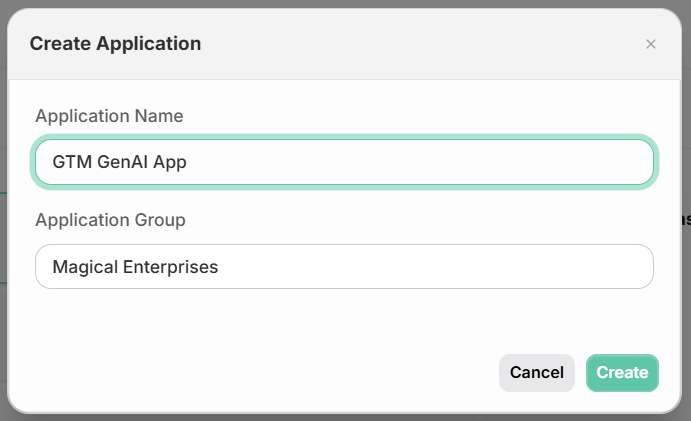Applications
Overview
In Pay-i, an Application refers to a specific service, product, or system that makes API calls to AI providers. Applications are the third tier in Pay-i's three-tier hierarchical structure, following Organizations and Groups.
Each application represents an individual service or system making AI provider requests and can contain one or more Use Cases. For detailed information about how Applications fit into Pay-i's overall structure, including API key assignment, see the Organizational Structure documentation.
Applications in Practice
Applications typically represent:
- Individual products or services your company offers
- Different environments (development, staging, production)
- Distinct systems or microservices that use AI capabilities
For example, in our scenario of a "Summarization Service," this application makes chat completion API calls to OpenAI to summarize documents for users like Jane.
Application Management
Creating Applications
Applications in Pay-i must be explicitly created through the dashboard interface:
-
Navigate to the Organization view
-
Click the "+ Create Application" button in the top-right corner


- In the modal dialog that appears:
- Enter an "Application Name" that describes your service or system
- Select an "Application Group" from the dropdown (or use the default). For more information about Groups, see the Groups documentation.
- Click "Create" to finish
When an application is created, Pay-i automatically generates API keys for it. These API keys are used to authenticate requests to Pay-i and are specific to that application.
Accessing API Keys
After creating an application:
- Go to the application's Settings page
- Find the API Keys section
- Copy the keys as needed for your implementation
For detailed instructions on API key management, see the Pay-i API Keys documentation.
Viewing Application Data
In the Pay-i dashboard, you can:
- See usage metrics for each application
- Compare costs across applications
- View application-specific limits and use cases
- Analyze performance and failure data by application
Application Settings
Each application has its own settings that control:
- Logging behavior (whether prompts and completions are stored)
- Default limits
- Default billing models
- User access permissions
Best Practices
Organization
- Logical Separation: Create separate applications for distinct services or products
- Environment Segregation: Use different applications for development, staging, and production
- Team Isolation: Consider separate applications for different teams if they need independent tracking
Naming Conventions
- Use clear, consistent names for your applications
- Include environment information if applicable (e.g., "Summarization-Prod", "Summarization-Dev")
- Consider including team or department names for organizational clarity
Security
- Rotate application API keys periodically
- Limit access to application API keys on a need-to-know basis
- Use different API keys for different deployment environments
Applications and Other Pay-i Concepts
Applications work with other Pay-i concepts in the following ways:
- Limits: Can be associated with specific applications
- Use Cases: Belong to specific applications
- Request Tags: Help categorize API calls within an application
- User IDs: Track end-user activity across an application
Understanding the Organizational Context
Applications exist within Pay-i's broader organizational hierarchy. For a detailed explanation of how Applications fit into the overall structure, including example organizational layouts, see the Organizational Structure documentation.
Updated 14 days ago
